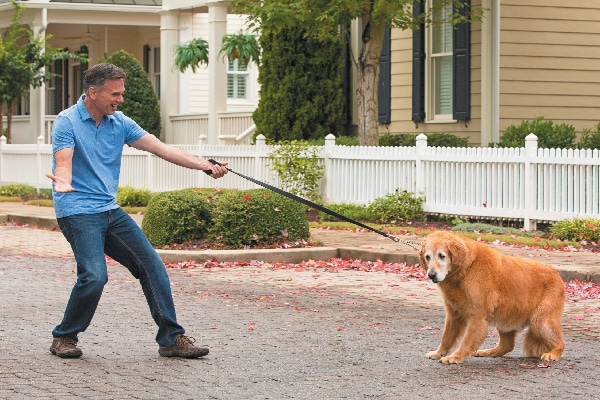The post The Latest in Dog Training by Jackie Brown appeared first on Dogster. Copying over entire articles infringes on copyright laws. You may not be aware of it, but all of these articles were assigned, contracted and paid for, so they aren’t considered public domain. However, we appreciate that you like the article and would love it if you continued sharing just the first paragraph of an article, then linking out to the rest of the piece on Dogster.com.
Thirty years ago, I was training my first dog, a sweet Golden Retriever named Jake. The first day, the trainer hauled out a bucket of choke chains in all sizes so we could select and purchase one for our dogs. He proceeded to teach everyone in the class to simultaneously jerk up on the choke chain and push down on the dogs’ rumps until they were forced into the sit position. There were no treats in this dog training class.
Jake failed the final exam. We didn’t do any more classes after that, but I wanted to teach my dog tricks, so I started training him myself. I just did what felt right: I used treats. That summer, I taught Jake to shake with both paws, roll over, speak and beg. He patiently held a sit-stay or down-stay while I dressed him up for photo shoots. The obedience school dropout ended up being the best trained dog I ever had.
Dog training trends

Dog training methods have changed — for the better. Photography ©inhauscreative | Getty Images.
Dog training has thankfully come a long way in the past three decades. Although some people still use aversion (physical corrections and intimidation) to train dogs, such methods are falling out of favor and being replaced with positive methods.
“People now are seeing how positive training works and how effective it is,” says Victoria Stilwell, dog trainer and star of the TV series It’s Me or the Dog. “The more people who understand the benefits of positive training — because people don’t want to hurt their dogs — the more change there will be.”
At one time, many trainers thought aversive training methods were fine because dogs didn’t have feelings. We now know what most dog lovers always knew — dogs have feelings and emotions — and using pain, fear or intimidation to train them is not OK.
“Many people still use harmful, antiquated techniques like choke collars, prong collars and electric shock collars,” says Jill Breitner, owner of SheWhisperer dog training. “Today, we know that using these old methods only shuts a dog down and, for many, makes them aggressive.”
According to Victoria, punishment does work in that it can stop a behavior. However, suppressing a behavior in one moment doesn’t lead to long-term change. “You might be teaching the dog to practice avoidance of a certain thing, but you’re not giving them something else to do,” she says. “We want to encourage learning. Positive training works to change behavior for the life of the dog.”
Punishment-based training methods are simply inhumane and also damage your relationship with your dog. “It’s all about the relationship,” Victoria says. “If you’re patrolling with a human partner, are you going to choke him? No, you’re not. Your partner would not work with you. You need your partner’s trust 100 percent, and you need to trust your partner.”
Why positive dog training works

Training your dog using treats is a win-win for everybody! Photography ©Seregraff | Getty Images.
With positive dog training, you teach the dog to do what you want with rewards (treats, praise or play). “Inappropriate behavior is redirected, the dog is shown what to do and then rewarded for it,” says Megan Stanley, CPDT-KA, CBCC-KSA, chair of the board of directors for the Association of Professional Dog Trainers and owner of Dogma Training & Pet Services in Calgary, Alberta, Canada. “Not only is it a more humane option, but it increases the likelihood of the dog repeating it, making it a powerful tool at changing or shaping a dog’s behavior.”
Positive dog training is also fun. After all, who doesn’t like treats and play? “We want an engaged, enthusiastic dog, not one who’s shut down and fearful,” Jill says. “Training with positive methods brings out the best in the dog, and why would we want anything else from and for our best friends?” When to use a trainer
You can train your dog on your own, but going to a dog training class is a great experience for both of you. You will learn from the trainer and from observing others in the class, and your dog will benefit from the socialization and practicing skills amidst distractions.
Megan believes there are two times when it’s especially important to use a professional trainer. “First is shortly after you bring your dog home, whether it’s a puppy or adult dog,” she says. “Too often, people who have owned a dog before think it’s OK to do the training on their own. They’re missing ideal socialization time for their dog to meet other dogs and people.” A certified reward-based trainer can explain critical behaviors to work on to avoid problems from developing.
If your dog ever shows signs of fear, reactivity or aggression, always consult a professional. “People hope the problem will disappear with age,” Megan says. “However, these behaviors often worsen and it becomes a much more complex and harder problem to change.”
Dog training tools
Our experts share their favorite training tools as well as those to avoid:
USE
- Treats/praise
- Toys/games
- Regular harness
- Anti-pull harness
AVOID
- Shock collar Prong/pinch collar
- Citronella spray collar
- Head halters
How to find a great positive trainer

How do you find a professional dog trainer? Photography ©damedeeso | Getty Images.
When evaluating a trainer, watch out for certain buzzwords. “If people talk about being the pack leader, or that you should be alpha or boss, that’s all language used by the more traditional, old-school camp,” Victoria says. “Run away from that. You don’t need to be your dog’s pack leader — you need to be your dog’s leader. You need to be your dog’s teacher. And you don’t need to do it by dominating your dog into submission, which is ridiculous.”
- apdt.com/about/trainer-search
- ccpdt.org/dog-owners/certified-dog-trainer-directory
- karenpryoracademy.com/find-a-trainer/#!directory/map
- positively.com
Want to become a dog trainer?
If you love dogs and are considering a career as in dog training, check out Victoria Stilwell’s six-month course at vsdogtrainingacademy.com.
Jackie Brown is a freelance writer from Southern California who specializes in the pet industry. Reach her at jackiebrownwriter.wordpress.com.
Read more about dog training on Dogster.com:
- Do You Have a Scared Puppy? What to Look For — and How to Help Him
- Dog Swimming Lessons: 11 Tips for Teaching Your Pup to Swim Safely
- How to Train a Dog to Walk on a Leash
The post The Latest in Dog Training by Jackie Brown appeared first on Dogster. Copying over entire articles infringes on copyright laws. You may not be aware of it, but all of these articles were assigned, contracted and paid for, so they aren’t considered public domain. However, we appreciate that you like the article and would love it if you continued sharing just the first paragraph of an article, then linking out to the rest of the piece on Dogster.com.
No comments:
Post a Comment